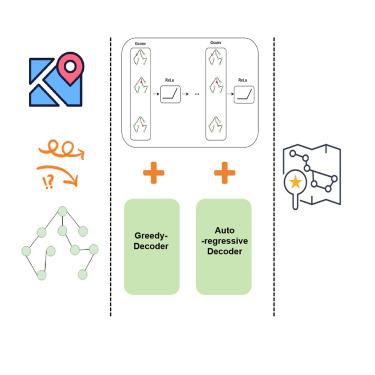Our official English website, www.x-mol.net, welcomes your feedback! (Note: you will need to create a separate account there.)
Dual hybrid frameworks combining graph convolutional network with decoding for covering location problem
iScience ( IF 5.8 ) Pub Date : 2024-04-23 , DOI: 10.1016/j.isci.2024.109803 Yao Zhang , Shaohua Wang , Haojian Liang , Xiao Li , Zhenbo Wang , Hao Lu
iScience ( IF 5.8 ) Pub Date : 2024-04-23 , DOI: 10.1016/j.isci.2024.109803 Yao Zhang , Shaohua Wang , Haojian Liang , Xiao Li , Zhenbo Wang , Hao Lu

|
The Covering Location Problem (CLP) is widely used for the efficient facility distribution. However, existing algorithms for this problem suffer from long computation times or suboptimal solutions. To address this, we propose two methods based on graph convolutional networks (GCN) to solve two types of covering location problems: the location set covering problem and the maximum covering location problem. The first method, GCN-Greedy, is a supervised algorithm that synergized with the Greedy algorithm as decoder. It designs a specialized loss function to train the model, tailored to the characteristics of the two covering location problems. The second method, reinforcement learning based on GCN with auto-regressive decoder (GCN-AR-RL), represents a reinforcement learning framework that integrates a GCN encoder with an auto-regressive decoder. The experimental results of these models demonstrate the remarkable accuracy and performance advantages. Additionally, we apply these two models to the realistic dataset and achieve good performance.
中文翻译:

将图卷积网络与解码相结合的双混合框架用于覆盖位置问题
覆盖位置问题(CLP)广泛用于高效的设施分配。然而,该问题的现有算法存在计算时间长或解决方案次优的问题。为了解决这个问题,我们提出了两种基于图卷积网络(GCN)的方法来解决两类覆盖位置问题:位置集覆盖问题和最大覆盖位置问题。第一种方法,GCN-Greedy,是一种监督算法,与作为解码器的 Greedy 算法协同作用。它设计了专门的损失函数来训练模型,针对两个覆盖位置问题的特点进行定制。第二种方法是基于 GCN 和自回归解码器的强化学习(GCN-AR-RL),代表了集成 GCN 编码器和自回归解码器的强化学习框架。这些模型的实验结果表明了显着的精度和性能优势。此外,我们将这两个模型应用于实际数据集并取得了良好的性能。
更新日期:2024-04-23
中文翻译:

将图卷积网络与解码相结合的双混合框架用于覆盖位置问题
覆盖位置问题(CLP)广泛用于高效的设施分配。然而,该问题的现有算法存在计算时间长或解决方案次优的问题。为了解决这个问题,我们提出了两种基于图卷积网络(GCN)的方法来解决两类覆盖位置问题:位置集覆盖问题和最大覆盖位置问题。第一种方法,GCN-Greedy,是一种监督算法,与作为解码器的 Greedy 算法协同作用。它设计了专门的损失函数来训练模型,针对两个覆盖位置问题的特点进行定制。第二种方法是基于 GCN 和自回归解码器的强化学习(GCN-AR-RL),代表了集成 GCN 编码器和自回归解码器的强化学习框架。这些模型的实验结果表明了显着的精度和性能优势。此外,我们将这两个模型应用于实际数据集并取得了良好的性能。



























 京公网安备 11010802027423号
京公网安备 11010802027423号